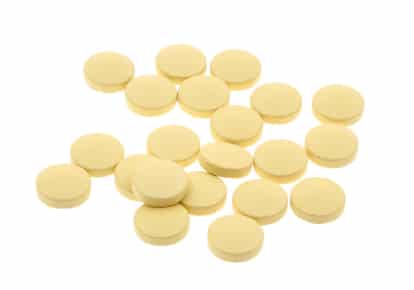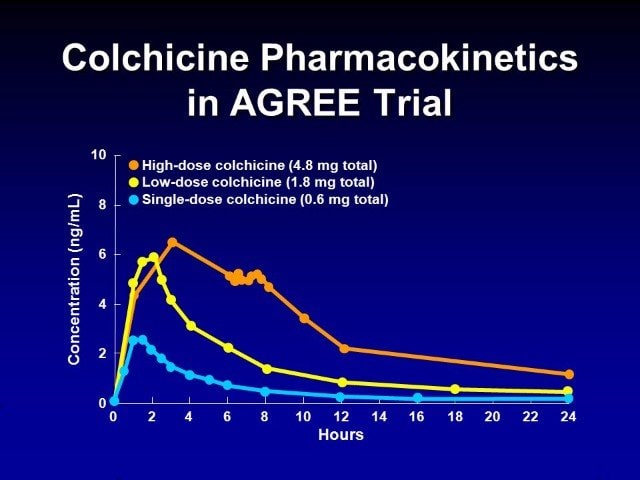Colchicine For Gout Attacks
Colchicine is a prescription drug (Brand Name: Colcrys) that treats gout extracted from plants of the genus Colchicum, a very poisonous plant with no know antidote and known for its’ toxicity. It has been around for about 2000 years as an effective gout treatment and its’ modern use in tablet form began in 1936. Benjamin Franklin suffered from gout and known to have brought Colchicum plants from Europe.
How does colchicine work?
Colchicine does not lower uric acid levels but works to block the inflammation caused by uric acid crystals, to relieve you of the pain, working very fast usually within 12-24 hours, slowing the inflammation. Whenever I get a gout attack, it is my go to drug, rushing to the doctor’s office to get a prescription and take about 3-4 a day for the first 2 days, then about 2 daily for another 2 days after that.
It’s the quick-fix miracle drug for us gout sufferers, that’s for sure! Supposedly, it doesn’t work for everyone but it does have a good pain reduction success rate, around 75% and colchicine should be taken within 12 hours of an attack to work most effectively. Make sure to drink 12 to 15 glasses of 8oz of water daily when taking colchicine making the drug work more effectively for you. Colchicine is usually taken in combination with other gout medications to help manage the symptoms.
The important part about taking colchicine is getting the dosage right, people have died from overdoses. The FDA recommended use is to take 1.2mg followed by 0.6mg one hour later is enough for a day totalling 1.8mg during a gout attack and to prevent gout attacks it is recommended to take 0.6mg once or twice a day for anyone older than 16 years old with a maximum dosage of 1.2mg a day. Rheumatologists now advise against taking unnecessary colchicine for long term preventative gout treatment and on a daily basis you should stop after taking 2 tablets and you should stop it after first few weeks of uric acid lowering therapy. I personally stop it once my big toe pain subsides enough that I can tolerate the pain of walking which is usually 4-5 days.
You’ll want to be consistent in taking colchicine on time as prescribed by your doctor. Missing a dose or not taking it on schedule can result in the drug not working as well. It might even stop working.
If you do miss a dose, take it right away. If it’s only a few hours until it’s time to take colchicine again, go ahead and just count the previous one and next one as a single dose. Do not attempt to make up for the missed dose by taking two as this can lead to serious side effects.
You’ll know the drug is working because you feel less pain in your affected joint. You should also experience less gout flares after taking colchicine.
What are the side effects?
If you suffer from kidney disease, liver disease, bone marrow disorders, inflammatory bowel disease or a low white blood cell count, you should not take colchicine and usually means the elderly should refrain from taking it.
The side effects that I have personally experienced are usually diarrhea, going to the bathroom every few hours and stomach cramps on the days I take 3-4 right after an attack. Other side effects include vomiting and nausea. It is very important to pay attention on how colchicine affects you personally and allopurinol is a better drug for long term treatment of gout.
Also allopurinol should be slowly introduced after a gout attack because in the beginning it can also trigger a gout attack. Remember colchicine stops an attack in its’ tracks while allopurinol works to reduce the uric acid levels in your body. Colchicine is for limited use while allopurinol is for long term use.
It was announced in January 2015 from Takeda Pharmaceuticals USA, the manufacturer of colchicine sold as Colcrys for acute gout flares, that a generic version will hit the market soon but didn’t specify on the new price. Presently brand-name Colcrys retails for roughly $6 per pill. There has been a lot of controversy ever since the product was approved in 2009 by the FDA since generic versions were ordered out of the market and there was a monopoly on the drug which explained the high cost of the pill. This is good news for gout sufferers who will now be able to afford colchicine at a lower and more affordable price.
Colchicine is also now available in capsule form in both generic and brand name form. The brand name for a capsule colchicine is Mitigare. Not all pharmacies sell colchicine so make sure to call ahead of time to find out.
Furthermore, on February 2019, it was announced that the FDA approved the first oral solution on colchicine for the treatment of gout flares. So now you can take colchicine orally for those 15% of elderly gout sufferers who have difficulty swallowing capsule or tablet drugs.
A 2020 study published in Arthritis Research & Therapy found that colchicine treatment may elevate the risk of having more diarrhea and other gastrointestinal issues but not any liver, muscle, sensory, infections, hematological issues or death according to their results.
Colchicine can also result in reduced blood cells in the body. This is quite risky since certain types of blood cells are responsible for fighting infections and forming blood clots. If you have a blood disorder, it might be difficult to get rid of an infection or heal a wound.
Another side effect of colchicine is rhabdomyolysis or muscle damage. If taken for 6 months or longer, it may damage your muscles and also your kidneys especially if you’re of senior age. If you’re already taking other medications alongside colchicine, this makes it even riskier. Make sure you speak with your doctor so they can prescribe a safer regimen for you.
Drug Interactions
Aside from colchicine, you should also be careful about the drugs that you take with it. Certain medicines don’t interact well with colchicine. Here are just some of them:
- HIV drugs including atazanavir, indinavir, saquinavir, nelfinavir, and ritonavir.
- Antifungal drugs like ketoconazole and itraconazole.
- Antibiotics like telithromycin and clarithromycin
- Antidepressants like nefazodone
- Antiarrhythmic drugs such as Digoxin
- Cholesterol drugs such as fluvastatin, pravastatin, lovastatin, atorvastatin, fibrates, simvastatin, and gemfibrozil
- Heart drugs such as diltiazem and verapamil
These medications, when taken alongside colchicine will raise the colchicine levels in your body leading to muscle damage. Some of them such as the heart drugs can cause constipation, diarrhea, nausea, and vomiting.
If you are currently taking any of the medications mentioned above, your doctor will reduce your colchicine dosage so as to avoid these side effects.
To ensure that you are taking just the right amount of colchicine, your doctor might check your blood count as well as your liver and muscle function. These are the areas of your body most affected by a colchicine overdose so if these aren’t working properly, your dosage should be reduced.
Food Interactions
There is a specific fruit to avoid when you’re on colchicine and that is grapefruit. This is because grapefruit causes the body to process colchicine less efficiently. Avoid consuming grapefruit or its juice when you’re on this medication.
In conclusion, a new gout drug is under development called Arcalyst supposedly has fewer side effects than colchicine serving the same role colchicine offers now for the gout sufferer. Make sure to also tell your doctor about any other medications you may be taking that may not mix too well with colchicine and create havoc for your health. What have been your experiences with colchicine, I’d like to hear them?


